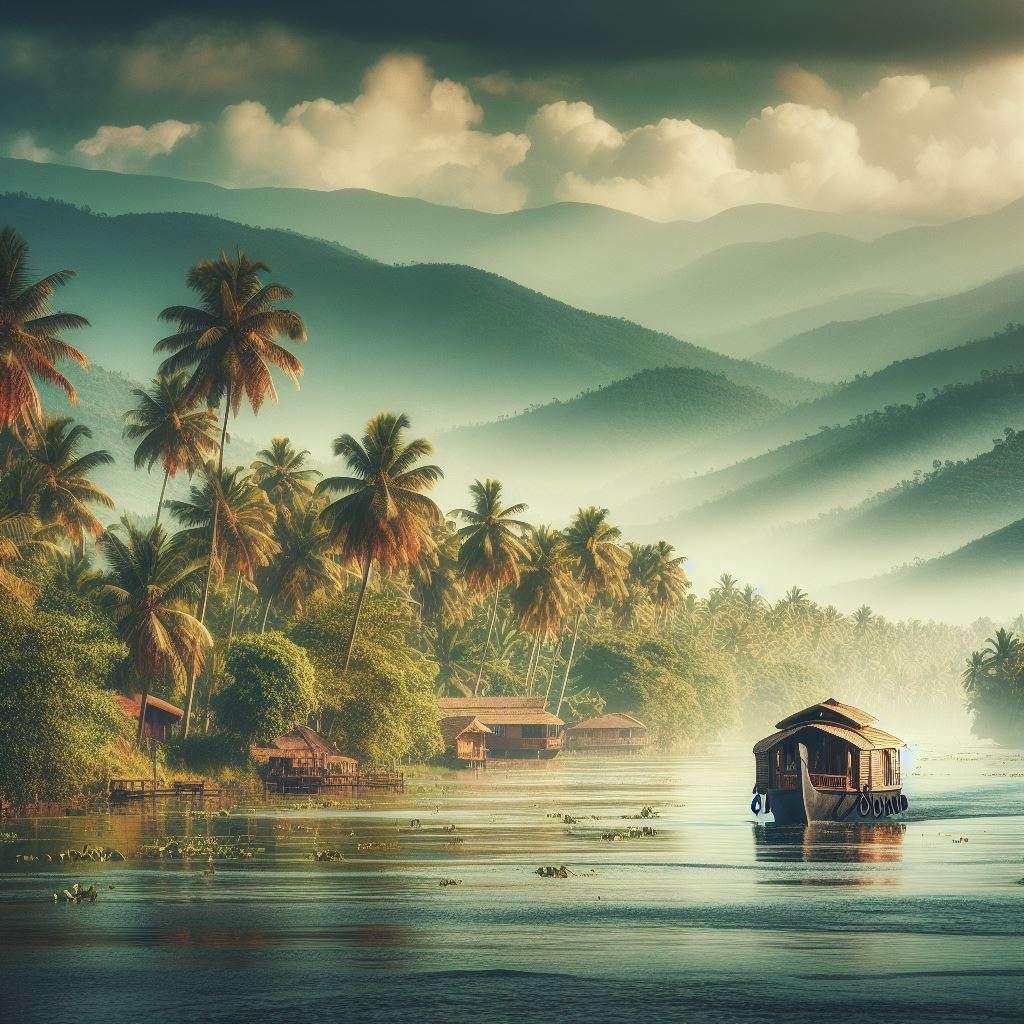Introduction to Tamil Nadu
Tamil Nadu, located in the southern part of India, is a state renowned for its rich cultural heritage, diverse landscapes, and historical significance. Bordered by the states of Kerala to the west, Karnataka to the northwest, and Andhra Pradesh to the north, Tamil Nadu’s geographical location offers a unique blend of experiences for travelers. The state is bounded by the Eastern Ghats to the north, the Nilgiri and Annamalai Hills to the west, and the Bay of Bengal to the east, creating a varied topography that includes sun-kissed beaches, lush hill stations, and fertile plains.
The climate of Tamil Nadu is predominantly tropical, characterized by hot and humid summers, moderate monsoons, and mild winters. This diverse climate supports a wide range of flora and fauna, making the state a haven for nature enthusiasts. The coastal areas, in particular, enjoy a moderate climate, making them ideal for tourism throughout the year.
Tourism plays a pivotal role in the economy of Tamil Nadu. The state is home to several UNESCO World Heritage Sites, ancient temples, and historical monuments that attract visitors from all corners of the globe. The vibrant culture, deeply rooted in traditions and arts, provides a unique experience for tourists. Furthermore, Tamil Nadu’s well-developed infrastructure, including airports, railways, and road networks, ensures that visitors can travel comfortably and conveniently across the state.
The importance of tourism to Tamil Nadu’s economy cannot be overstated. The sector generates significant revenue, creates employment opportunities, and promotes the preservation of cultural and historical sites. As a result, Tamil Nadu continues to invest in the development and promotion of its tourist attractions, ensuring that it remains a top destination for travelers seeking to explore the rich tapestry of Indian heritage and natural beauty.
Chennai, the capital city of Tamil Nadu, stands as a dynamic gateway to South India, blending modernity with rich traditions. A visit to Chennai is incomplete without experiencing its iconic Marina Beach, one of the longest urban beaches in the world. Stretching over 13 kilometers along the Bay of Bengal, Marina Beach is a hub of activity, drawing both locals and tourists for its serene sunrises, evening strolls, and vibrant atmosphere.
Fort St. George is another must-visit landmark in Chennai. Established in 1644 by the British East India Company, this historic fort now houses the Tamil Nadu legislative assembly and a museum showcasing artifacts from the British colonial period. It stands as a testament to Chennai’s historical significance and its pivotal role during the colonial era.
The Kapaleeshwarar Temple is a stunning example of Dravidian architecture and a vital religious site in Chennai. Dedicated to Lord Shiva, the temple’s intricately carved gopuram (tower) and vibrant rituals offer a glimpse into the city’s spiritual life. The temple is a focal point during the Arubathimoovar festival, which attracts thousands of devotees and visitors from across the country.
Chennai’s local markets, such as T. Nagar and George Town, are a shopper’s paradise. These bustling bazaars are famed for their array of silk sarees, jewelry, and traditional handicrafts, providing a sensory overload with their vibrant colors, textures, and sounds. Exploring these markets offers an authentic taste of Chennai’s commercial and cultural vibrance.
Cultural festivals like Pongal and the Chennai Music Season are integral to the city’s identity. Pongal, the harvest festival, is celebrated with fervor, showcasing traditional dances, music, and culinary delights. The Chennai Music Season, held in December, transforms the city into a hub of classical music and dance performances, attracting artists and enthusiasts from around the globe.
Culinary exploration in Chennai is a treat, with a diverse range of offerings from traditional South Indian fare to contemporary cuisine. Iconic dishes such as dosa, idli, and filter coffee are a must-try, encapsulating the flavors and culinary heritage of the region.
Mahabalipuram: The Land of Ancient Temples
Mahabalipuram, also referred to as Mamallapuram, stands as a testament to Tamil Nadu’s rich historical tapestry. This coastal town is renowned for its UNESCO World Heritage sites, which comprise some of the most magnificent rock-cut temples and monuments. These ancient structures not only highlight the architectural prowess of the Pallava dynasty but also reflect the cultural and religious ethos of the time.
One of the most iconic landmarks in Mahabalipuram is the Shore Temple. Perched on the edge of the Bay of Bengal, this temple complex dates back to the 8th century and is dedicated to Lord Shiva and Lord Vishnu. The Shore Temple’s strategic location and architectural brilliance make it a significant study for historians and architects alike. The intricate carvings and the temple’s ability to withstand the ravages of time and tide add to its allure.
Another notable attraction is the Five Rathas, also known as Pancha Rathas. These monolithic rock-cut structures, each carved from a single granite stone, are named after the Pandavas from the Indian epic Mahabharata. Each Ratha (chariot) is unique in its design and serves as a fine example of Dravidian architecture. The precision and artistry involved in creating these structures continue to amaze visitors and scholars.
Beyond its historical monuments, Mahabalipuram is also famed for its pristine beaches. The golden sands and azure waters make it a perfect destination for relaxation and leisure. The beaches here are not just about natural beauty but also serve as venues for various cultural events and festivals that promote Tamil culture. Sculptors and artisans often display their work along the beachfront, offering a glimpse into the region’s rich artistic heritage.
Mahabalipuram’s blend of historical significance, architectural marvels, and natural beauty makes it a must-visit destination in Tamil Nadu. Whether you’re a history enthusiast, an architecture buff, or simply looking to unwind by the sea, Mahabalipuram offers a unique and enriching experience.
Pondicherry: A French Colonial Gem
Pondicherry, known officially as Puducherry, is a fascinating destination that beautifully marries French colonial architecture with rich Indian culture. This coastal town is a testament to its colonial past, with the French Quarter standing as a prominent reminder. The French Quarter, also known as “White Town,” is characterized by its charming, tree-lined streets, vibrant bougainvillea, and mustard-yellow colonial villas. Walking through these streets, one can easily feel transported to a different era, with the architecture narrating tales of its historical significance.
One of the must-visit spots in Pondicherry is Auroville, an experimental township founded in 1968. Auroville aims to be a universal town where people from all countries can live in peace and progressive harmony. At the heart of Auroville lies the Matrimandir, a golden spherical structure that serves as a place for silent concentration. This unique location draws visitors for its serene atmosphere and its commitment to human unity.
Promenade Beach is another highlight that attracts both locals and tourists. Stretching for around 1.5 kilometers along the Bay of Bengal, the Promenade is perfect for a leisurely walk or to simply relax by the sea. The area is dotted with significant landmarks such as the French War Memorial and the statue of Mahatma Gandhi, adding a touch of historical intrigue to the scenic beauty.
The French influence in Pondicherry extends beyond architecture and into the very heart of its lifestyle and cuisine. The town’s culinary scene is a delightful blend of French and Indian flavors, offering everything from croissants and baguettes to spicy curries and dosa. Cafés and bakeries in Pondicherry exude a distinct French charm, making dining an experience to savor.
The lifestyle in Pondicherry reflects a laid-back, cosmopolitan vibe, with a mix of traditional Tamil culture and French sophistication. This unique confluence makes Pondicherry a captivating destination that offers a glimpse into a world where two cultures coexist harmoniously.
Madurai: The City of Temples
Madurai, one of the oldest cities in Tamil Nadu, is a treasure trove of historical and cultural significance. At the heart of Madurai lies the renowned Meenakshi Amman Temple, an exemplar of Dravidian architecture. This majestic temple, dedicated to Goddess Meenakshi and Lord Sundareswarar, boasts intricately carved gopurams (gateway towers) and a sprawling complex that attracts devotees and tourists alike. The temple’s stunning architecture, adorned with thousands of sculptures, is a testament to the artistic prowess of the era.
Another architectural marvel in Madurai is the Thirumalai Nayakkar Palace. Built in the 17th century by King Thirumalai Nayak, the palace showcases a blend of Dravidian and Rajput architectural styles. The grandeur of its celestial courtyard, the royal throne chamber, and the intricately designed stucco work on its domes and arches offer a glimpse into the opulence of the Nayak dynasty.
Madurai’s cultural vibrancy is further highlighted during its numerous festivals. The Chithirai Festival, celebrated in April, is one of the most significant events in the city. This festival, which commemorates the celestial wedding of Meenakshi and Sundareswarar, features elaborate processions, traditional music, and dance performances that bring the city’s streets to life. Similarly, the Float Festival, held in January, sees beautifully decorated deities being taken on a procession atop a float in the Mariamman Teppakulam tank.
In addition to its architectural and cultural heritage, Madurai is also known for its traditional crafts. The city is famous for its intricate handloom textiles, particularly the Madurai Sungudi sarees, which are renowned for their unique tie-and-dye patterns. Artisans in Madurai also excel in crafting brassware, wooden toys, and stone sculptures, making it a hub for traditional crafts.
Madurai, with its blend of historical landmarks, vibrant festivals, and traditional crafts, offers a rich tapestry of experiences for any traveler. The city’s enduring legacy and cultural heritage make it a must-visit destination in Tamil Nadu.
Ooty: The Queen of Hill Stations
Ooty, officially known as Udhagamandalam, is a prominent hill station nestled in the Nilgiri Hills of Tamil Nadu. Renowned for its breathtaking landscapes, Ooty offers a serene escape from the hustle and bustle of city life. The town is enveloped by lush greenery, expansive tea gardens, and the lingering charm of the colonial era, making it a favored destination for tourists and nature enthusiasts alike.
One of the prime attractions in Ooty is the Ooty Botanical Gardens. Spanning over 55 acres, these gardens are home to a diverse collection of flora, including rare and exotic plant species. Visitors can stroll through meticulously maintained lawns, admire vibrant flowerbeds, and witness the 20-million-year-old fossilized tree. The annual flower show held here is a spectacle not to be missed, drawing crowds from all corners of the globe.
Another must-visit spot is Ooty Lake, an artificial lake constructed in 1824 by John Sullivan, the then Collector of Coimbatore. The lake, set amidst eucalyptus trees and surrounded by lush greenery, offers a variety of recreational activities, including boating. The adjacent boathouse provides pedal boats, motorboats, and rowboats, making it a perfect spot for family outings and leisurely afternoons.
The Nilgiri Mountain Railway, often referred to as the “Toy Train,” is yet another highlight of Ooty. This UNESCO World Heritage Site offers a scenic journey through the verdant hills, dense forests, and picturesque landscapes. The train ride, which starts from Mettupalayam and ascends to Ooty, provides an unforgettable experience, showcasing the natural beauty of the region.
In addition to Ooty’s main attractions, nearby destinations such as Coonoor also warrant a visit. Located just 17 kilometers from Ooty, Coonoor is known for its tea estates, the Sim’s Park botanical garden, and the stunning viewpoints like Dolphin’s Nose and Lamb’s Rock. The smaller, quieter hill station complements Ooty’s charm, offering visitors a more tranquil, yet equally captivating experience.
Kanyakumari: The Southern Tip of India
Kanyakumari, located at the southernmost tip of the Indian subcontinent, is a confluence of the Indian Ocean, the Bay of Bengal, and the Arabian Sea. Renowned for its picturesque sunrise and sunset views, this coastal town offers a unique blend of natural beauty and historical significance.
One of the town’s most iconic landmarks is the Vivekananda Rock Memorial. Perched on a small island, this memorial commemorates Swami Vivekananda’s visit in 1892. Accessible by ferry, the site provides a serene atmosphere ideal for meditation and reflection. The memorial’s architecture, blending traditional Indian styles with modern elements, is a testament to the town’s rich cultural heritage.
Adjacent to the memorial stands the towering Thiruvalluvar Statue, a 133-foot tall tribute to the famed Tamil poet and philosopher, Thiruvalluvar. This imposing structure, representing the 133 chapters of his seminal work, the Thirukkural, symbolizes the enduring influence of Tamil literature and philosophy. The statue’s grandeur and the panoramic view of the surrounding seas make it a must-visit attraction.
Kanyakumari Temple, also known as the Kumari Amman Temple, is another significant landmark. Dedicated to the goddess Kumari Amman, an incarnation of Parvati, the temple is a revered pilgrimage site. Its Dravidian architecture, intricate carvings, and spiritual ambiance draw devotees and tourists alike. The temple’s history is interwoven with legends and myths, adding to its mystical allure.
Beyond its landmarks, Kanyakumari holds a special place in India’s cultural and historical landscape. It is a melting pot of diverse traditions, reflected in its festivals, cuisine, and local crafts. The town’s geographical location has made it a significant maritime hub historically, fostering trade and cultural exchange across oceans.
In essence, Kanyakumari is a destination that offers more than just scenic views. It is a place where history, culture, and natural beauty converge, providing a holistic experience for travelers. Whether it’s witnessing the breathtaking sunsets or exploring the town’s historical landmarks, Kanyakumari promises an enriching journey.
Conclusion: The Diverse Beauty of Tamil Nadu
Tamil Nadu stands as a testament to the harmonious blend of natural beauty, rich cultural heritage, and profound historical significance. From the serene beaches of Marina and Mahabalipuram to the verdant hills of Ooty and Kodaikanal, the state offers an array of landscapes that cater to every traveler’s preferences. Tamil Nadu’s architectural marvels, such as the Brihadeeswarar Temple and the intricate structures of Madurai’s Meenakshi Temple, narrate tales of a glorious past and showcase the state’s unparalleled craftsmanship.
The cultural vibrancy of Tamil Nadu is equally captivating. Traditional art forms, including Bharatanatyam and Carnatic music, provide a window into the state’s soul. Festivals like Pongal and Tamil New Year are celebrated with fervor, offering visitors a chance to immerse themselves in local customs and traditions. The bustling markets, aromatic cuisine, and warm hospitality further enhance the unique charm of this southern gem.
For history enthusiasts, Tamil Nadu’s numerous UNESCO World Heritage Sites, such as the Group of Monuments at Mahabalipuram and the Great Living Chola Temples, are a treasure trove of ancient history and architectural brilliance. These sites not only reflect the artistic and engineering prowess of bygone eras but also offer insight into the region’s socio-cultural evolution.
When planning a visit to Tamil Nadu, practical travel tips can significantly enhance the experience. It is advisable to travel during the cooler months from November to February to avoid the intense summer heat. Respecting local customs and traditions is crucial, especially when visiting religious sites. Engaging local guides can provide deeper insights into the historical and cultural contexts of various attractions.
In conclusion, Tamil Nadu’s diverse beauty promises an enriching and unforgettable travel experience. Whether you are a nature lover, a history buff, or a cultural enthusiast, Tamil Nadu invites you to explore its multifaceted allure and create memories that will last a lifetime.




